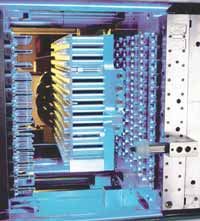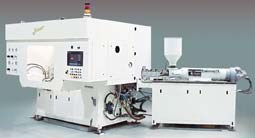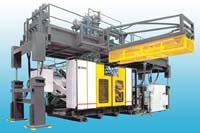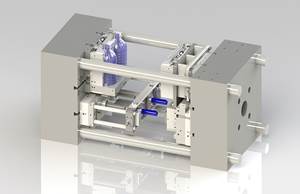Blow Molding - Higher Output Vies With Flexibility
The emphasis in blow molding equipment introductions at NPE 2003 is on higher output capability and greater versatility to take on emerging markets.
The emphasis in blow molding equipment introductions at NPE 2003 is on higher output capability and greater versatility to take on emerging markets. In PET bottles, equipment suppliers are boasting unheard-of production rates. Suppliers of preform-making systems are matching that trend by pushing injection cavitation levels to new heights. New extrusion-blow models are engineered for better energy efficiency (particularly the all-electric models), higher cavitation levels, and refined coextrusion capability. In technical-parts molding, new accumulator-head designs compress color- and tool-change times and accept larger molds for extended-layflat (flat-panel) parts. Some of these new machines are tailored for enhanced compatibility with integrated production cells.
PET reaches 60,000/hr
One of the more striking introductions at the show is a Sidel rotary reheat stretch-blow system that sets a new benchmark for productivity at 60,000 PET bottles/hr. For half-liter, monolayer bottles, the previous maximum was 50,000/hr. The new SBO-24 DC (24-station, dual-cavity) machine is said to be the first that can keep up with the rotary volumetric fillers recently adopted for water and carbonated soft-drink (CSD) packaging. It therefore makes in-line blowing and filling feasible. The new machine also reportedly uses a novel preferential heating system that occupies one-third less space than before.
Krones says it can match the new benchmark with its Contiform SK40 reheat machine, which will be announced though not exhibited at the show. This one-sided, 40-cavity machine is said to achieve 60,000 bottles/hr when running single-serve, monolayer PET bottles. Krones will demonstrate a heat-setting model: the one-sided, eight-cavity Contiform H, which will be molding single-serve PET containers.
Higher productivity and heat setting will also be show themes for SIG Beverages North America. It will show a SIG Corpoplast reheat machine from its new-generation Series III for the first time in the U.S. The one-sided, 20-station Blowmax 20 Series III unit has up to 3L bottle capability. At the show it will run 0.5L water bottles at 30,000 bottles/hr. Series III units incorporate linear ovens capable of faster tool changes, full mechanical preform stretching for improved wall distribution, and faster mold opening and closing. Productivity is up 15% from earlier models. The Series III line includes one-sided models with four to 18 stations.
Meanwhile, the reach of SIG’s Series III platform is being extended to include a double-sided version. The new 16D unit has 16 stations (32-cavities) and capacity of 50,000 bottles/hr. SIG also plans to roll out “E” versions of Series III units with heat-setting capability for making hot-fillable and pasteurizable bottles.
Sipa North America has increased output of its SFR rotary reheat stretch-blowing system by coming out with the first dual-sided model. At the show, Sipa plans to run 20-oz CSD containers on its new SFR 16/32, a 16-station, 32-cavity model, which is capable of 40,000 bottles/hr at a maximum bottle size of 1L. Its vertical mold-opening design is said to make preform and bottle movements more efficient.
France’s ADS is showcasing a two-stage PET machine line available in one- to six-cavity versions. On the show floor will be a two-cavity, G62 model, rated at 3200 bottles/hr. U.S. sales manager Jerome Kirszenger says it offers particular benefits when running flat or asymmetric bottles due to a special index heating system and extra preform heating and conditioning zones. ADS recently set up a technical support center in Atlanta.
Just a few months ago, Kortec raised the bar on high-output coinjection molding of three-layer preforms for barrier PET food bottles. Kortec combined a 72-cavity preform mold with a 300-ton Husky press to realize 50% more output at only 25% higher cost than the previous 48-cavity system. Husky’s micro-pitch technology permits tight preform spacing.
By showtime, Kortec plans to surpass that achievement by unveiling a 144-cavity “Ultra” coinjection system for narrow-neck CSD bottles. Tooling would be mated to a new Husky injection machine to be unveiled at the show. Kortec v.p. John Kermet says cycle time is similar to that for monolayer PET preforms and output is 35,000/hr.
Kortec will also introduce a three-layer preform system for lower-volume requirements. The two- to eight-cavity “Intro” system uses a 150-ton Arburg injection press and is designed for 8 to 12 million preforms/yr.
Stretch-blow flexibility
Among one-station injection stretch-blow machines, Uniloy Milacron is broadening its U750 platform to include a unit dedicated to wide-neck containers. The new U750-130 has a blowing clamp force of 60 tons and an injection clamp of 130 tons. It is said to impart excellent clarity and neck-finish precision to PET, PS, PP, PVC, and PC food, cosmetic, and pharmaceutical containers, and is designed for quick changes between numerous bottle programs in low- to medium-volume runs. The machine can be configured for anything from two-cavity molding of bottles up to 16L size with 135-mm neck-diam. to 14-cavity molding of 0.4L bottles with 28-mm necks. An integrated injection tooling cartridge reduces tool-change times from the typical 12 hr to about 1 hr.
Automa North America has just been re-established after an absence of a year or so. A sales and technical service center is in place in Buffalo, N.Y. The company plans to highlight an upgraded NSD-50 one-stage injection stretch-blow unit that includes a Moog-Buhl PC controller with self-diagnostic capability.
Aoki Laboratory America will demonstrate a new high-output version of its three-station injection stretch-blow family. The SBIII-250LL-50S comes with one to 10 cavities for 120-cc to 3L bottles. An eight-cavity unit for 4800 bottles/hr will be shown.
Nissei ASB Co. is introducing the ASB-150DP, a higher-output extension of the current 650 Series of four-station injection stretch-blow machines. Compared with the earlier model EXH-3, the ASB-150DP has 50% higher clamp force (165 tons) and 30% faster dry-cycle time. The unit can have two to 16 cavities with maximum bottle sizes of 15L and 300 cc, respectively. Also making its U.S. debut at the show is Nissei’s ASB-50MB, a compact, low-cost model with two to six cavities and maximum bottle sizes of 2.5L and 30 cc, respectively. It is built in India and is aimed at lower-volume, market-entry applications.
Husky Injection Molding Systems will not bring its relatively new IndexSB machine to the show but will be talking about it. This machine was first introduced at K 2001 in Germany and has since found North American customers. Metroliner Plastics in Richmond, Va., is using a model with 12 injection and six blowing cavities to run PET dry spice bottles at 4600/hr. Another firm in Mexico is using the IndexSB to mold 250-cc, 500-cc, and 1L PP paint cans.
Injection-blow refinements
Jomar plans to run two new injection-blow molding units on the show floor. One is the revamped 72-ton Model 85-S configured with a horizontal injection barrel rather than the vertical barrel that has been customary for Jomar. A horizontal 85-S with eight cavities will mold 75-cc clarified-PP wide-mouth bottles. Features include proportional hydraulics, closed-loop shot control, and an Allen-Bradley SLC-5/03 controller. Sales manager Lou Maiero reaffirms Jomar’s view that most users are still best served by the traditional vertical design with infusion-molding and split-nozzle features.
Changing safety requirements affecting blow molders are addressed by a Jomar Model 40 upgrade to surpass current ANSI safety standards. A six-cavity version of the “New Look” Model 40 will run 10-cc PET bottles with its work area fully encapsulated in sheet metal to meet the new standard.
Dima Inc., U.S. subsidiary of South Korea’s Dongshin Hydraulics, plans to display an injection-blow machine that’s new to North America. The three-station, 65-ton unit will run HDPE eye-fluid bottles in a 12-cavity tool.
An upgraded version of a specialized injection-blow machine made by Germany’s Ossberger for molding TPEs into automotive CVJ and rack-and-pinion boots will be running at distributor FGH Systems’ booth. The Pressblower DSE 140, with a new PC-based controller, makes parts up to 140 g and 180 mm diam.
Extrusion blow variety
In extrusion blow molding, new all-electric machines and systems dedicated to making coextruded parts are likely to dominate the show floor.
Two years ago, Magic of Italy introduced its EP series all-electric shuttle presses in a one-sided (ND) version. Now, it plans to display a two-sided, six-cavity system, the EP3 D, running an 800-cc HDPE household-chemical bottle at 2200/hr. It will be part of a full production cell including a gravimetric blender, granulator, and chiller. Versus hydraulic equivalents, all-electric machines reportedly save about 50% in energy and 75% in maintenance costs. They are also said to reduce downtime and improve bottle quality. Long-term, Magic plans to apply all-electric technology across its entire blow molding line.
Japan Steel Works (JSW) is expanding its all-electric line with a model designed to meet demand for versatile machines to produce smaller (100-cc to 1.5L) PP and HDPE bottles for medical, cosmetic, and food markets. Model JEB-R is a dual-parison machine with a head designed to minimize weld lines and to permit easy set-up (e.g., electric parison-thickness adjustment).
A new single-cavity, 24-station vertical wheel specifically designed to make six-layer, coextruded barrier bottles at up to 4500/hr will be announced by Wilmington Machinery. The machine’s layout has been modified to extend mold length and minimize flash generation.
Automa will display the improved Plus AT15D machine for six-layer coextruded containers used to package mayonnaise, ketchup, and juices. It has four parison heads with 125-mm center distance.
Jomar is offering a new extrusion blow machine for two-layer, soft-touch cosmetic PP and HDPE bottles. Model 6-D is an alternating shuttle with two-layer die head offering increased output, extended center distance (3 x 140 mm), and increased clamp force (15 tons). A redesigned carriage reduces energy use.
Graham Machinery Group (GMG) says its new GEC-4/600 rotary shuttle (vertical wheel) model boosts output by around 80% versus the existing GEC-4/425 model, a four-parison, 16-cavity unit. The GEC-4/600 has six parisons and 24 cavities as well as a 30% faster dry cycle. The new model shares the 100-mm center distance of the GEC-4/125. The new machine incorporates integrated leak-detection and vision QC equipment, a more efficient mechanism for takeout and trim, and an upgraded in-mold labeling module. The GEC-4/600 production cell at NPE will run 8-oz stock juice containers at 7200/hr.
A production version of GMG’s C30 reciprocating-screw machine, first unveiled as a prototype at K 2001, will be running 5-gal PC water bottles. The 25-ton unit with 100-g maximum shot weight is claimed to be fastest in its class.
Both of the new GMG units incorporate a proprietary, PC-based controller, which the company plans to extend to its full machine line in coming months.
Rocheleau Tool & Die plans to display an eight-cavity RS-25 reciprocating-screw machine configured for up to quart-sized HDPE bottles and designed to accept the newly popular full-body shrink labels. Labels are applied in a post-molding step to contoured bottles. The RS-25 to be shown has throughput of 3000 quart bottles/hr and is said to be a viable option for up to 30 million bottles/yr.
Bekum America plans to demonstrate two new double-station systems targeted at flexible production of polyolefin and PC bottles. The 06 Series BM-406D and BM-506D handle parts of up to 12L and 20L respectively. Their extended daylight suits them for in-mold labeling, while linear mold carriers speed carriage movement, reduce travel distance, and cut energy use.
Bekum is also introducing the single-cavity BA-25, a new option for flexible production of 5-gal PC water bottles and up to 20L HDPE oil containers.
New from SIG Blowtec is a version of its Type 4 linear shuttle machines for polyolefin drink, cosmetic, and household-chemical bottles. BlowPac 4/6-100 D is a dual-sided, six-station (12-cavity) system aimed at medium-volume runs. The unit incorporates a new advanced controller.
FGH Systems, distributor of German-built Uniloy B&W shuttle-style packaging machines, plans to exhibit a new model specially designed to work with tools made for other machine brands. The new unit in effect converts what were once dedicated tools into “universal” ones.
Technical parts progress
Uniloy Milacron is filling gaps in its Tracker line of accumulator-head equipment for large parts by adding three new sizes. The T-1000 and T-2300 have respective clamp tonnages of 140 and 295 tons, while platen dimensions are 64 x 64 and 86 x 86 in. Meanwhile, the new T2900, with 325-ton clamp and 74 x 110 in. platens, becomes the largest standard model. Tracker units come with a PC-based Xtreem XP controller. Also new are redesigned accumulator-heads in the 10- to 50-lb range that accept extra-large tools, suiting them for use in the booming market for large, flat blow molded panels.
Three novel capabilities are combined in a 30-lb accumulator head to be displayed by Davis-Standard. A proprietary spiral diverter realizes 70% reduction in color-change time while also minimizing knit lines and improving parison uniformity, says technical manager Mark Panaro. A bronze (rather than steel) push-out plunger minimizes bleed and reduces body wear when changing colors, he adds. Finally, the new head extends the size of tools that can be accommodated to 22-in. O.D. versus 18 in. before. Up to 26-in. tools will soon be accommodated, enhancing the ability to blow mold large flat panels.
Jackson Machinery plans to demonstrate an automated production cell for blow molded LDPE sheathing used to anchor seat belts to car floors. Current production of such parts is typically done on dual-head, single-cavity accumulator machines that require manual labor to finish the parts. Instead, Jackson’s system uses a dual-head, dual-cavity design to double output without sacrificing the 14-sec cycle time. At the same time, it reduces labor costs by integrating trim, hole-punch, and inspection steps in a production cell.
Emission standards for automotive fuel tanks are getting more stringent due to regulatory change in California. In response, JSW plans to introduce the NV120-1CCC-MLG, a one-station continuous coextrusion blow molder for making six-layer tanks using HMW-HDPE, EVOH, tie-resin, and regrind layers. JSW’s machine has a 120-ton clamp and 1320-lb/hr extruder capacity.
SIG Kautex views the U.S. market as increasingly receptive to 3D suction blow molding of nylon or PP auto under-hood ducting. Applications include fuel filler pipes, convoluted coolant pipes, and air ducts. At the show, the company will mold such parts on an SB8 3D suction blow molder with an 8-ton clamp.
Related Content
50 Years...600 Issues...and Still Counting
Matt Naitove marks his first half-century in plastics reporting, with a few of his favorite headlines.
Read MoreAt NPE, Cypet to Show Latest Achievements in Large PET Containers
Maker of one-stage ISBM machines will show off new sizes and styles of handled and stackable PET containers, including novel interlocking products.
Read MoreKrones Acquires Netstal
Krones adds PET preform injection molding to its bottle blowing and filling capabilities, as well as cap molding and expansion into medical, food and other markets.
Read MoreSolve Four Common Problems in PET Stretch-Blow Molding
Here’s a quick guide to fixing four nettlesome problems in processing PET bottles.
Read MoreRead Next
Why (and What) You Need to Dry
Other than polyolefins, almost every other polymer exhibits some level of polarity and therefore can absorb a certain amount of moisture from the atmosphere. Here’s a look at some of these materials, and what needs to be done to dry them.
Read MoreHow Polymer Melts in Single-Screw Extruders
Understanding how polymer melts in a single-screw extruder could help you optimize your screw design to eliminate defect-causing solid polymer fragments.
Read MoreUnderstanding Melting in Single-Screw Extruders
You can better visualize the melting process by “flipping” the observation point so that the barrel appears to be turning clockwise around a stationary screw.
Read More



















.png;maxWidth=300;quality=90)















